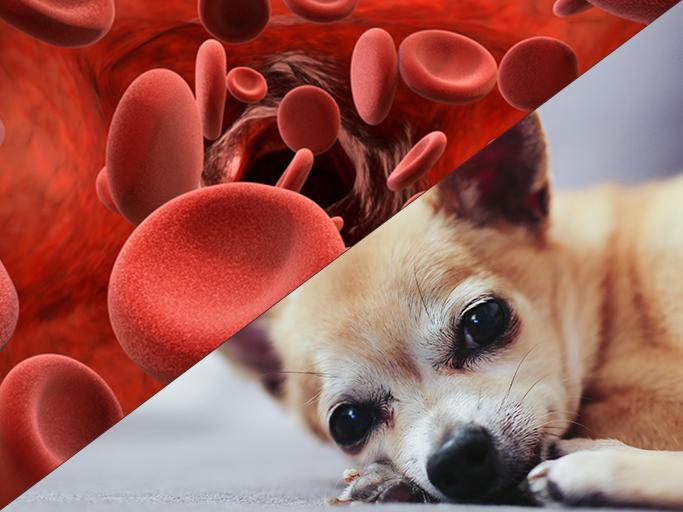Hemolytic Anemia In Dogs



See files for Dogs
Anemia is not a disease in itself, but a blood disorder which often results from disease, as well as other causes. It describes the condition of low red blood cells and/or low hemoglobin in the dog's blood. There are several types of anemia, each with its particular characteristics and respective treatments. Also known as immune-mediated hemolytic anemia (IMHA) in dogs, autoimmune hemolytic anemia is one type of canine anemia characterized by a weakened immune system. This disease attacks and eradicates red blood cells in the body.
If your dog is suffering from hemolytic anemia or is showing symptoms take a look at our article on hemolytic anemia in dogs, discussing its causes, symptoms and treatment, as well as other information which can help you care for your dog.
What is hemolytic anemia in dogs?
Red blood cells, alternatively known as erythrocytes, are used mainly for transporting oxygen around the body. They do so thanks to a protein they contain known as hemoglobin. Without red blood cells, the body would be unable to function, so there needs to be a certain amount contained in blood serum for the dog to stay alive. When there is insufficient amounts of red blood cells and/or hemoglobin, the dog will develop anemia.
There are different types of canine anemia. One of the main types is due to blood loss, often due to either external or internal trauma. We can see this if we see blood in the dog's feces, among other symptoms. It can also be due to an inability to create new red blood cells, something which can be pathological in origin.
Canine immune-mediated hemolytic anemia (IMHA) is a type of anemia which is characterized by the early destruction of red blood cells in the dog's bloodstream. This destruction prevents these cells from functioning properly. These red blood cells are produced in the bone marrow. Once released, they are prematurely eradicated and cannot provide their required function, nor can they regenerate to form new blood cells.
IMHA in dogs is a rare, but serious disease which requires specific treatment and careful monitoring by the dog's guardian. If not treated, it can lead to death.
Learn more about caring for anemic dogs by viewing our article on diet for dogs with anemia.
Causes of hemolytic anemia in dogs
There are several reasons why a dog develops immune-mediated hemolytic anemia. The most frequent causes of IMHA in dogs include:
- Genetic inheritance: as with many other diseases, hemolytic anemia can be passed down genetically from the dog's parents. Symptoms in this case may show from birth, but they can develop as they mature or be .
- Infections: this is when anemia is caused by bacteria and microorganisms that attack the red blood cells. Infections can also occur due to a wound or internal bleeding.
- Side effects of drugs: anemia can also occur as a side-effect of the ingestion of specific drugs or chemical agents.
- Excessive consumption of vitamin C: an uncontrolled consumption of ascorbic acid (Vitamin C) can cause autoimmune hemolytic anemia in dogs.
Hemolytic anemia in dogs can be primary or secondary to an underlying disease. In primary cases of IMHA in dogs, the dog will develop the conditions regardless. In secondary canine hemolytic anemia, the anemia is only triggered thanks to another issue. For example, a tumor on the spleen can result in increased destruction of red blood cells. It is also possible for a dog with IMHA to have a genetic predisposition to the disorder, but it is activated by another health problem.
Symptoms of hemolytic anemia in dogs
The symptoms of a IMHA in dogs include:
- Fatigue: it is one of the most significant characteristics of this disease. It happens because there is a decrease in the number of cells that send oxygen to the brain.
- Tachycardia (accelerated heart-rate): takes place because the heart tries to increase the amount of pulsations so that blood can reach the tissues and brain. As oxygen-sending cells are diminished, a dog's heart rhythm is accelerated to counteract this decrease.
- Jaundice: is a very frequent symptom in this type of anemia, since there is a significant increase in bilirubin levels. Bilirubin is a yellow compound found in bile and is formed by the destruction of red blood cells. Learn more with our article on why a dog's skin is turning yellow.
- Dark urine: dark urine occurs when there is an excess of bilirubin in the blood. This is different from a dog peeing a little fresh blood.
- Hypersplenism: refers to an increase in splenic activity. When the spleen is more active than normal, it destroys its red blood cells thereby preventing the transit of oxygen to a dog's body.
Other symptoms characteristic of hemolytic anemia include:
- Fatigue
- Headaches
- Weakness
- Vomiting
- Diarrhea
- Accelerated breathing
- Loss of appetite
- Paleness of the gums
If you notice any of these symptoms in your dog, we suggest consulting your veterinarian immediately.

Diagnosis of hemolytic anemia in dogs
If your dog is presenting the aforementioned symptoms, we recommend taking them to the vet immediately. A professional will be able to analyze the causes and diagnose the dog correctly. Diagnosing IMHA in dogs includes performing a physical examination with pressure point analysis. This physical examination will also aid in detecting any sensitivity or inflammation in the spleen.
A veterinarian will then perform a blood test on the dog, measuring both hemoglobin and reticulocyte levels. If necessary, they might perform other tests in order to rule out any other pathologies. These can include infections diseases, parasitosis or chronic illnesses, among others. Early diagnosis is crucial in the survival for a dog suffering from hemolytic anemia.
Hemolytic anemia in dogs treatment
There are several treatments for immune-mediated hemolytic anemia in dogs. Some include:
- Blood transfusions: aims to rapidly increase the number of red blood cells in the body by replacing the cells destroyed by the disease.
- Corticosteroids: a type of hormone used to prevent the dog's immune system from forming new antibodies.
- Antiparasitic drugs: when hemolytic anemia is caused by infections or parasitic agents, it is common for the veterinarian to prescribe medication for deworming the dog. This is done with the aim of eliminating possible microorganisms that may be affecting the dog's health.
- Surgery: surgery is usually a last resort treatment, used in desperate measures when other treatments haven't worked. Surgery is usually recommended when the spleen becomes frequently inflamed, therefore it becomes essential that it is removed.

Is there a cure for hemolytic anemia in dogs?
A cure for hemolytic anemia in dogs will depend on the main cause of its development. Depending on the degree of the severity of the anemia, emergency measures to restore the number of red blood cells in the body will have to take place. Once treatment is done, a specialist will determine following treatment.
The prognosis of autoimmune hemolytic anemia depends on the cause and individual patient. Studies show that there is a survival rate of 50%-80% of dogs that suffer from this disease. However, early detection is vital[1].

This article is purely informative. AnimalWised does not have the authority to prescribe any veterinary treatment or create a diagnosis. We invite you to take your pet to the veterinarian if they are suffering from any condition or pain.
If you want to read similar articles to Hemolytic Anemia In Dogs, we recommend you visit our Infectious diseases category.
1. Garden, O. A., Kidd, L., Mexas, A. M., Chang, Y. M., Jeffery, U., Blois, S. L., Fogle, J. E., MacNeill, A. L., Lubas, G., Birkenheuer, A., Buoncompagni, S., Dandrieux, J., Di Loria, A., Fellman, C. L., Glanemann, B., Goggs, R., Granick, J. L., LeVine, D. N., Sharp, C. R., Smith-Carr, S., … Szladovits, B. (2019). ACVIM consensus statement on the diagnosis of immune-mediated hemolytic anemia in dogs and cats. Journal of veterinary internal medicine, 33(2), 313–334.
https://doi.org/10.1111/jvim.15441








